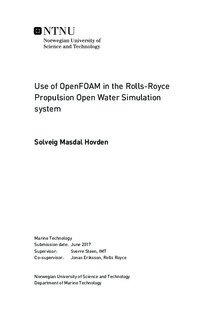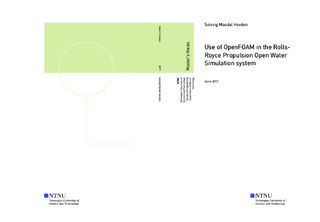| dc.description.abstract | Rolls-Royce Research \& Technology propulsion department has developed a fully automated open water simulation tool called Propulsion Open Water Simulations. This system can be used for any propulsion and thruster system. This enables propeller designers without any prerequisite skills in Reynolds-averaged Navier-Stokes based computational fluid dynamics methods to run advanced simulations. The solver in Propulsion Open Water Simulations is the commercial license based software ANSYS Fluent. This is an expensive solution and it has therefore been proposed to change the solver to the open source software OpenFOAM. The main objectives of this master thesis are to investigate the possibility of using OpenFOAM as a solver in Propulsion Open Water Simulations, generate a mesh that is suitable for OpenFOAM and optimize the solver settings to ensure robustness and manageable computational effort. The validation of the system is done using Azipull120 and Azipull150. The results are validated using experimental data and numerical results from Propulsion Open Water Simulations.\\
A conformal mesh, suitable for OpenFOAM is created. The quality of the grid generated by BOXERMesh is not completely satisfactory with the setup used in this thesis. The mesh is computationally expensive. A reason for this is the leading edge of the propeller, it easily gets rough due to cells collapsing. Small cells are required in this region. Numerical schemes and solver parameters are chosen based on investigations and common practice. The results from the steady state and transient simulations are within i tolerable accuracy. All simulations converged smoothly, except for the four lowest advance ratios for the Azipull150. \\
OpenFOAM can be used as solver in Propulsion Open Water Simulations, but the high mesh requirements from OpenFOAM and the low-quality grids generated by BOXERMesh combined is a challenge. It is possible to overcome this, but a higher number of cells than for the current Propulsion Open Water Simulations system seems unavoidable. Changing the mesher could possibly be a solution. It should preferably be an open source mesher, with scripting possibility. The robustness of the system is important to avoid excessive manual work and delays in results. It also important to get reliable results for all simulations. | |

